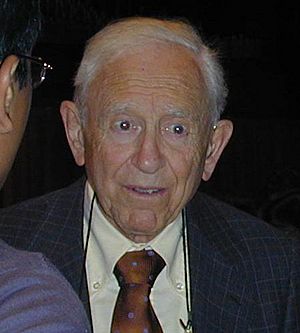Franco Modigliani facts for kids
Quick facts for kids
Franco Modigliani
|
|
|---|---|

Modigliani in 2000
|
|
| Born | 18 June 1918 |
| Died | September 24, 2003 (aged 85) |
| Nationality | Italian, United States |
| Field | Financial economics |
| Alma mater | The New School (PhD) Sapienza University of Rome (Laurea) |
| Doctoral advisor |
Jacob Marschak |
| Doctoral students |
Albert Ando Robert Shiller Mario Draghi Lucas Papademos |
| Influences | J. M. Keynes, Jacob Marschak |
| Contributions | Modigliani–Miller theorem Life-cycle hypothesis MPS model |
Franco Modigliani (1918 - 2003) was a famous Italian-American economist. He won the Nobel Memorial Prize in Economics in 1985. He taught at important universities like the University of Illinois at Urbana–Champaign, Carnegie Mellon University, and MIT Sloan School of Management.
Contents
Early Life and Education
Franco Modigliani was born on June 18, 1918, in Rome, Italy. His father was a children's doctor, and his mother was a volunteer social worker. His family was Jewish Italian.
He started university at 17, studying law at the Sapienza University of Rome. In his second year, he won a national economics contest. He even received his award from Benito Mussolini, who was Italy's leader at the time.
However, because of new laws against Jewish people in Italy, Modigliani left for Paris in 1938. He went with his girlfriend, Serena Calabi. He briefly returned to Rome to finish his university degree in 1939.
Later that same year, he and Serena moved to the United States. He continued his studies at the New School for Social Research in New York. He earned his PhD in 1944. His doctoral paper was considered very important and new.
Career Highlights
From 1942 to 1944, Modigliani taught economics and statistics at Columbia University and Bard College. In 1946, he became a citizen of the United States.
In 1948, he joined the faculty at the University of Illinois at Urbana–Champaign. From 1952 to 1962, he taught at Carnegie Mellon University.
In 1962, he became a professor at the MIT. He continued to work there for the rest of his life, even teaching in his final months.
Important Economic Ideas
Modigliani made many important contributions to economics. Here are some of his key ideas:
Life-Cycle Hypothesis
Starting in the 1950s, Modigliani helped create the life-cycle hypothesis. This idea explains how people save money. It suggests that people try to keep their spending steady throughout their lives. For example, they save money when they are working. Then, they spend those savings when they retire.
Rational Expectations
The idea of rational expectations is also linked to Modigliani. In 1954, he wrote a paper with Emile Grunberg about it. This idea suggests that people make smart decisions about the future. They use all the information they have to predict what will happen.
Modigliani–Miller Theorem
In 1958, while at Carnegie Mellon, Modigliani worked with Merton Miller. Together, they developed the Modigliani–Miller theorem. This theorem is about how companies get money. It says that, under certain conditions, a company's value doesn't change based on whether it raises money by selling shares (equity) or by borrowing money (debt).
Monetary and Fiscal Policy
In the early 1960s, Modigliani and Albert Ando responded to a paper by Milton Friedman. This started a long discussion among economists. It was about whether monetary policy (controlling money supply) or fiscal policy (government spending and taxes) was better for the economy.
Non-Inflationary Rate of Unemployment
In 1975, Modigliani and his former student Lucas Papademos introduced the "NIRU." This stands for the non-inflationary rate of unemployment. It's a level of unemployment below which prices (inflation) start to rise. It was an improvement on an older idea called the "natural rate of unemployment."
Modigliani Risk-Adjusted Performance
In 1997, Modigliani and his granddaughter, Leah Modigliani, created a new way to measure investments. It's called the "Modigliani Risk-Adjusted Performance." This tool helps people see how well an investment portfolio is doing. It also considers how much risk the investment has compared to the market.
Awards and Recognition
In October 1985, Franco Modigliani received the Nobel Prize in Economics. He won it for his important work on saving and financial markets.
In 1985, he also received MIT's James R. Killian Faculty Achievement Award. In 1997, he received an honorary degree from the University of Naples Federico II in Italy.
Later in his life, Modigliani became a trustee for Economists for Peace and Security. He was also an important advisor to the Federal Reserve. In the 1960s, he helped design a model that guided how the US government managed its money for many years.
His papers and writings are kept at Duke University's Rubenstein Library.
Personal Life
In 1939, while in Paris, Modigliani married Serena Calabi. They had two children, Andre and Sergio.
Franco Modigliani passed away in Cambridge, Massachusetts, in 2003. He was still working at MIT at the time. His wife, Serena, was also very active in politics and believed strongly in people having a say in their government. She died in 2008.
See also
 In Spanish: Franco Modigliani para niños
In Spanish: Franco Modigliani para niños

